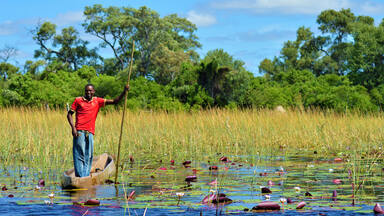The World Heritage Committee,
- Having examined Document WHC/18/42.COM/7B,
- Recalling Decisions 38 COM 8B.5 and 40 COM 7B.78, adopted at its 38th (Doha, 2014) and 40th (Istanbul/UNESCO, 2016) sessions, respectively,
- Welcomes the cancellation of all petroleum and metals prospecting licenses in the buffer zone and the State Party’s commitment to continue monitoring the activities, but noting the location of the alternative licensing zones close to the buffer zone and the property, requests the State Party to ensure that an Environmental Impact Assessment (EIA), including an assessment of potential impacts on the Outstanding Universal Value (OUV) of the property, is undertaken before any exploration activity is initiated, and submit it to the World Heritage Centre for review by IUCN;
- Appreciates the collaboration between the States Parties of Botswana, Angola and Namibia through the Permanent Okavango River Basin Water Commission (OKACOM) to ensure any proposed major development within the Okavango watershed is subject to an EIA, and that there is a coordinated mechanism to notify each State Party of activities that can have transnational impacts;
- Taking into account the potential impact on the property’s OUV of any development leading to water abstraction within the watershed and the complexity and the extent of the basin, urges the States Parties of Botswana, Angola and Namibia to assess impacts of any development at the strategic level and at the landscape scale through a comprehensive Strategic Environmental Assessment (SEA), in line with IUCN’s World Heritage Advice Note on Environmental Assessment;
- Notes with appreciation the initiation of the review of the Okavango Delta Management Plan in order to reflect the property’s World Heritage status, to improve the effectiveness of the institutional arrangements and to address outstanding conservation and management issues, and reiterates its request to the State Party to continue its efforts to:
- Expand and strengthen programmes, which accommodate traditional resource use for livelihoods, user access rights, cultural rights and access to opportunities to participate in the tourism sector, in keeping with the property’s OUV,
- Address a range of other protection and management issues including governance, stakeholder empowerment, management planning, management capacity, and control of invasive alien species;
- Notes with concern that an EIA for the veterinary cordon fences and aerial wildlife surveys could not be undertaken due to financial constraints, and also requests the State Party to provide further financial support to the conservation of the property;
- Further noting that the construction of a cable-stayed bridge across the panhandle area of the property and hardening of the associated approach road has begun at Mohembo based on a 2009 EIA, considers that the measures identified in the EIA are insufficient as they do not take into account the property’s World Heritage status, and further requests the State Party to revise the EIA, in line with the IUCN Advice Note, prior to continuing the work, in order to include an assessment of the potential impacts of the construction and use of the bridge and the road on the property’s OUV, and submit it to the World Heritage Centre for review by IUCN;
- Requests furthermore the State Party to submit to the World Heritage Centre, by 1 December 2019, an updated report on the state of conservation of the property and the implementation of the above, for examination by the World Heritage Committee at its 44th session in 2020.
